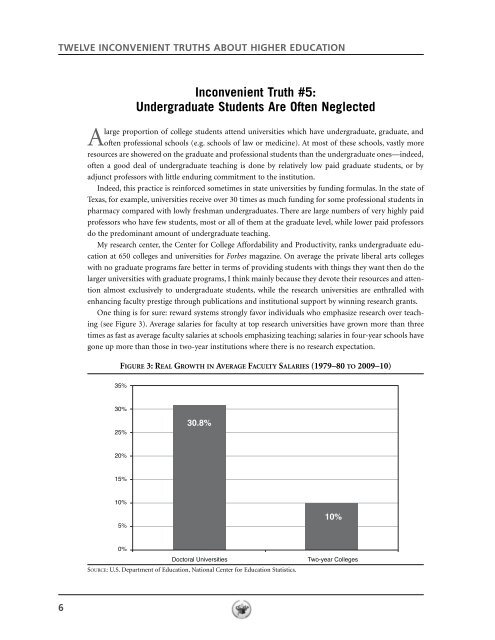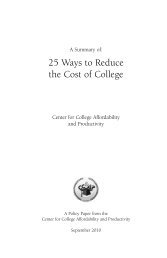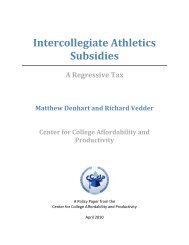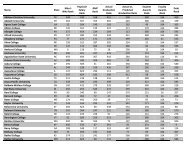Twelve Inconvenient Truths About Higher Education - The Center for ...
Twelve Inconvenient Truths About Higher Education - The Center for ...
Twelve Inconvenient Truths About Higher Education - The Center for ...
Create successful ePaper yourself
Turn your PDF publications into a flip-book with our unique Google optimized e-Paper software.
TWELVE INCONVENIENT TRUTHS ABOUT HIGHER EDUCATION<br />
<strong>Inconvenient</strong> Truth #5:<br />
Undergraduate Students Are Often Neglected<br />
Alarge proportion of college students attend universities which have undergraduate, graduate, and<br />
often professional schools (e.g. schools of law or medicine). At most of these schools, vastly more<br />
resources are showered on the graduate and professional students than the undergraduate ones—indeed,<br />
often a good deal of undergraduate teaching is done by relatively low paid graduate students, or by<br />
adjunct professors with little enduring commitment to the institution.<br />
Indeed, this practice is rein<strong>for</strong>ced sometimes in state universities by funding <strong>for</strong>mulas. In the state of<br />
Texas, <strong>for</strong> example, universities receive over 30 times as much funding <strong>for</strong> some professional students in<br />
pharmacy compared with lowly freshman undergraduates. <strong>The</strong>re are large numbers of very highly paid<br />
professors who have few students, most or all of them at the graduate level, while lower paid professors<br />
do the predominant amount of undergraduate teaching.<br />
My research center, the <strong>Center</strong> <strong>for</strong> College Af<strong>for</strong>dability and Productivity, ranks undergraduate education<br />
at 650 colleges and universities <strong>for</strong> Forbes magazine. On average the private liberal arts colleges<br />
with no graduate programs fare better in terms of providing students with things they want then do the<br />
larger universities with graduate programs, I think mainly because they devote their resources and attention<br />
almost exclusively to undergraduate students, while the research universities are enthralled with<br />
enhancing faculty prestige through publications and institutional support by winning research grants.<br />
One thing is <strong>for</strong> sure: reward systems strongly favor individuals who emphasize research over teaching<br />
(see Figure 3). Average salaries <strong>for</strong> faculty at top research universities have grown more than three<br />
times as fast as average faculty salaries at schools emphasizing teaching; salaries in four-year schools have<br />
gone up more than those in two-year institutions where there is no research expectation.<br />
FIGURE 3: REAL GROWTH IN AVERAGE FACULTY SALARIES (1979–80 TO 2009–10)<br />
35%<br />
30%<br />
25%<br />
30.8%<br />
20%<br />
15%<br />
10%<br />
5%<br />
10%<br />
0%<br />
Doctoral Universities<br />
SOURCE: U.S. Department of <strong>Education</strong>, National <strong>Center</strong> <strong>for</strong> <strong>Education</strong> Statistics.<br />
Two-year Colleges<br />
6







